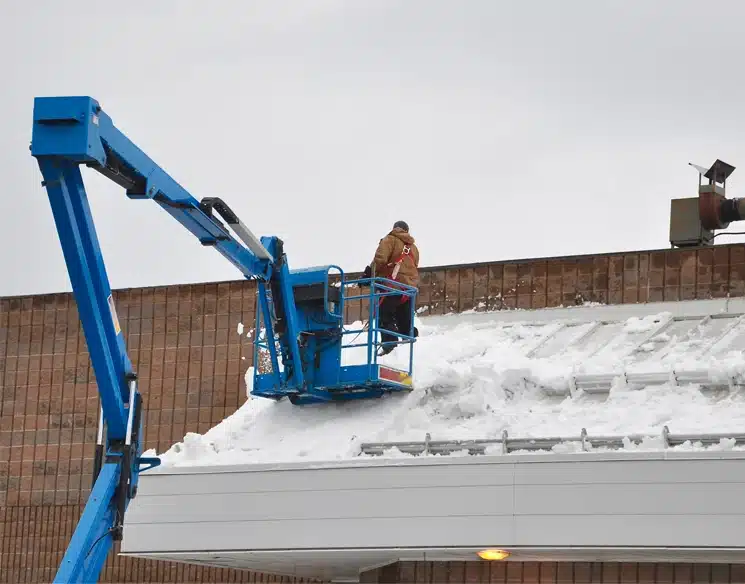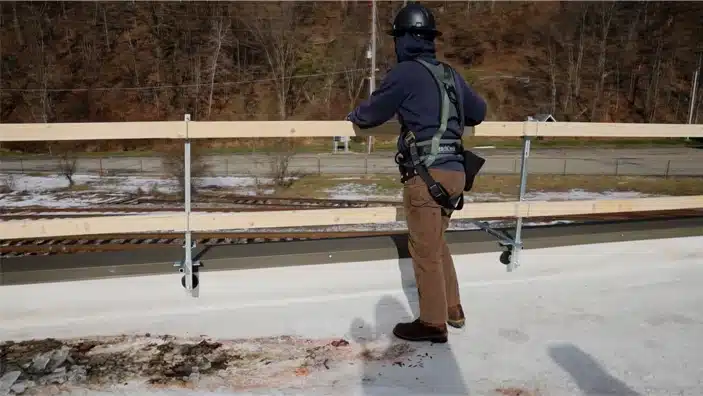
As winter approaches, the need for effective fall protection becomes even more critical. The colder months bring a unique set of challenges that demand a thorough understanding of safety measures. Adhere to OSHA’s recommended work practices to ensure safety in cold weather. However, special considerations must be taken into account for fall protection equipment and workers at height during the winter months.
In this article, we’ll explore essential tips and strategies to master fall protection in cold weather, ensuring a secure working environment for everyone involved.
Understanding FALL PROTECTION CHALLENGES IN COLD WEATHER
Before delving into specific tips, it’s crucial to understand why fall protection is particularly challenging in cold weather. The drop in temperature can affect equipment performance, reduce visibility, and introduce icy or slippery surfaces. Workers must be equipped with the knowledge and tools to navigate these challenges seamlessly.
ICE AND SNOW
Winter transforms rooftops into potential danger zones, with ice and snow conspiring to create treacherous fall hazards. While the best practice is to avoid rooftop maintenance during winter, certain circumstances may necessitate it. In such cases, taking robust precautions is paramount to ensure safety. Even the slightest misstep or stumble can transform into a hazardous fall situation when icy conditions prevail.
Essential Winter Rooftop Safety Measures:
1. Secure Tie-Off: If you find yourself compelled to venture onto a rooftop during winter, ensure that you are always securely tied off to an appropriate anchor point. This precautionary measure prevents potential falls and provides crucial safety icy conditions. Whenever feasible, opting for a restraint system over a fall arrest system can significantly enhance safety in elevated work environments. To appreciate this choice, it’s essential to understand the fundamental difference between the two.
A restraint system is designed to prevent workers from reaching a position where a fall could occur. On the other hand, a fall arrest system is reactive and comes into play when a fall has already occurred. It includes components like harnesses, lanyards, and anchor points designed to arrest the fall and mitigate the impact forces on the worker’s body. While crucial for certain tasks, a fall arrest system assumes that a fall has happened and focuses on minimizing its consequences.
2. Non-Slip Footwear: The right footwear can be a game-changer in icy and snowy conditions. Equip yourself with non-slip footwear to enhance traction, minimizing the risk of slipping and falling on slippery surfaces. Sturdy and slip-resistant boots are essential allies in the battle against winter rooftop hazards.

3. Passive Fall Protection: Consider incorporating passive fall protection options, such as guardrails, when working on winter rooftops. Guardrails act as a protective barrier, creating a physical boundary that reduces the likelihood of accidental falls. This proactive measure adds an extra layer of defense against the unpredictable nature of winter weather.
Wind
When it comes to fall protection in cold weather, one often overlooked factor is the wind. While online wind information is readily available, relying solely on ground-level readings can be a potential pitfall. The wind speeds experienced at ground level may significantly differ from those encountered at heights, increasing by 5, 10, 15 MPH, or more. Failing to account for this discrepancy can catch workers, including lift and crane operators, off guard.
Scaffolding Vulnerabilities: Scaffolding, if not properly constructed and secured, becomes particularly susceptible to unexpected wind challenges. In an attempt to shield themselves from the cold wind, workers may be inclined to add sheeting. However, without strategically placed openings for the wind to pass through, this seemingly protective measure can turn the scaffold into a sail, risking its collapse.
Sails in Disguise: Everyday materials like plywood sheets or tarps, commonly used for weather protection, can unwittingly act as sails. In windy conditions, they have the potential to carry individuals right off elevated work areas, such as buildings or roofs. Workers holding onto these materials or situated in their path may face serious risks.
Wind Tunnels and Structural Impact: Specific parts of a structure can transform into wind tunnels, intensifying the impact of wind. This creates unforeseen challenges for workers navigating elevated areas. To address this, especially if your work involves regular access to roofs or long-term construction projects, investing in a personal weather station is a prudent choice. This ensures accurate wind readings tailored to your specific locations, empowering you and your team with information that holds real significance.
Choosing the Right Gear: A Winter-Ready Toolkit
Don Your Harness Over Winter Clothing: The recommended practice is to wear a full-body harness over winter clothing. This ensures better visibility during inspections and reduces the likelihood of clothing interfering with buckles and snaphooks. Cold weather can make materials less pliable. Take extra care to adjust the harness in a way that accommodates the reduced flexibility of both the harness and the clothing underneath. A properly adjusted harness in winter not only enhances safety but also provides the freedom of movement essential for working efficiently in chilly conditions.
*Special Attention*: When warmer months return, it’s crucial to revisit your fall protection routine. Heavy clothing, although necessary for winter, can lead to loose straps on your harness. These straps, if not addressed, pose a serious hazard in the event of a fall.
Invest in Thermal Insulation: In cold weather, thermal insulation is key. Ensure that harnesses, lanyards, and other fall protection gear are designed to withstand low temperatures. Look for materials that remain flexible and functional in freezing conditions.
Anti-Slip Footwear: Icy surfaces pose a significant threat. Equip workers with anti-slip footwear to provide traction on slippery terrain. This simple addition can make a substantial difference in preventing falls.
Visibility-Enhancing Clothing: Reduced visibility is a common issue in winter. Opt for high-visibility clothing with reflective elements to ensure workers are easily seen, especially in low-light conditions.
Regular Equipment Checks: A Habitual Necessity
Checking your fall protection gear is always a critical safety practice, but it takes on heightened significance during the cold winter months. The unique challenges posed by winter weather can impact the functionality and effectiveness of fall protection equipment, making regular inspections an indispensable aspect of ensuring the safety of workers at heights.
Pre-Use Inspections: Regularly inspect all fall protection equipment before each use. Cold temperatures can impact the integrity of materials, making it crucial to identify and replace any compromised gear promptly.
Temperature-Dependent Adjustments: Be mindful of temperature-related adjustments. Buckles and straps may require different settings in cold weather, so ensure that all adjustments are made according to the prevailing conditions.
Specialized Training for Cold Weather Conditions
Avoid The Hazard: Whenever feasible, refrain from working at height in harsh weather conditions. If it becomes necessary, implement precautions to consistently monitor incoming weather. Winter weather is known for its unpredictability and severity. It is crucial to avoid having your workers at height when a winter storm unexpectedly rolls in. Prioritize safety by staying vigilant and making informed decisions based on weather conditions. Consider rescheduling for a day with more favorable work conditions whenever possible.
Educate Your Team: Provide specialized training that addresses the unique challenges of fall protection in cold weather. Make sure your team understands the impact of weather conditions on equipment and how to adapt their approach accordingly.
Emergency Response Protocols: In colder climates, the risk of hypothermia and frostbite is heightened. Include emergency response protocols in your training to ensure that workers know how to react swiftly and effectively in case of cold-related injuries. Ensure that your team is ready to safely execute rescues in winter conditions.
The Role of Proper Documentation
Detailed Cold Weather Procedures: Incorporate cold-weather-specific procedures into your fall protection plan. This documentation should outline step-by-step processes for ensuring safety in winter conditions. Make certain your fall protection plan includes the necessary gear for your team to work safely in winter conditions and outlines a detailed rescue plan, including prompt contact with emergency medical services in the event of a fallen worker.
Regular Review and Updates: Safety protocols should be dynamic. Regularly review and update your cold weather fall protection procedures to incorporate lessons learned and address any emerging challenges.
Conclusion: Staying Safe in The Cold at height
Mastering fall protection in cold weather is a multifaceted challenge that demands attention to detail, the right gear, and continuous training. By investing in thermal insulation, anti-slip footwear, and specialized training, you equip your team with the tools they need to stay safe in winter conditions. Regular equipment checks and proper documentation further solidify your commitment to creating a secure working environment, ensuring that everyone returns home safely, even when the temperatures drop. Stay warm, stay safe!